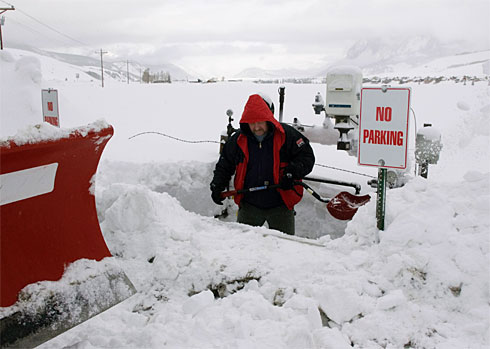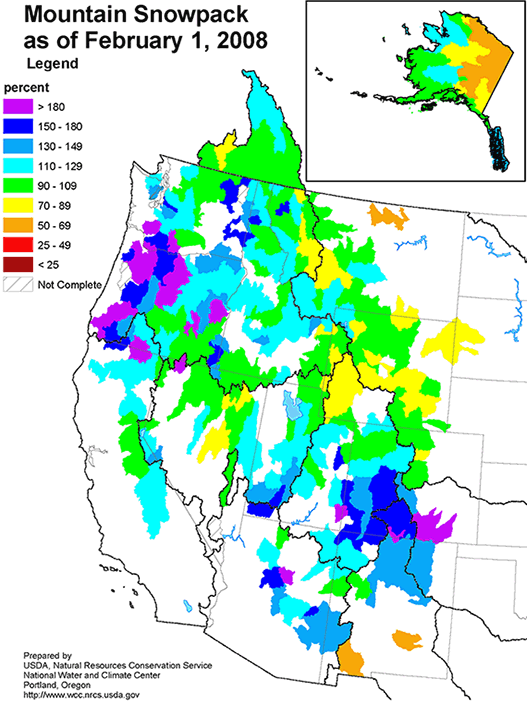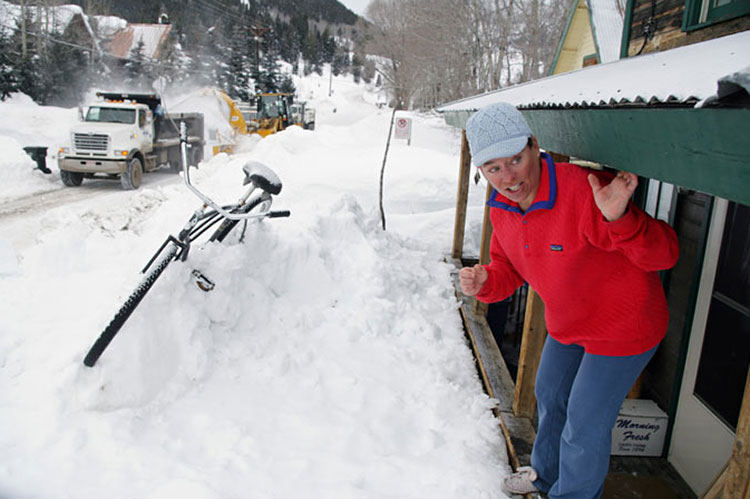
Amazing Snowfalls Could Help Dry West
By Alan Gomez
USA Today
Heavy snowfall in the West this winter is likely to have a major positive impact on a drought that has dried up water supplies and parched farmland for the past eight years.

Photo: Larry Eberhart of Salida, Colo., digs out a natural gas connection for Crested Butte South near Crested Butte, Colo. on Feb. 14 after a snow storm passed through the area. (By Nathan Bilow, AP)
The heaviest snowfall in 10 years has produced snowpack levels 180% above normal in some areas and a return to normal snowpack levels in most other areas.
In Colorado, this year's snowfall is 132% above normal and the most since 1997, according to said Mike Gillespie, snow survey supervisor for the U.S. Department of Agriculture's Natural Resources Conservation Service. And the snow season still has several weeks to go.
"We'd been seeing improvement in parts of the West, then it dives back into drought the next year. But this year, you're seeing widespread recovery," Gillespie said.
Gillespie and others said that while the good news does not necessarily mean an end to the drought, it does means that water supplies will likely be abundant this summer and reservoirs can partially fill up again.
At Lake Powell — one of two large reservoirs along the Colorado River — officials predict a 50-foot rise when the winter snowpack melts. That would be the largest rise in a decade for a lake that is currently at 45% capacity, said Paul Davidson, a hydrologist with the U.S. Bureau of Reclamation.
Davidson and others said the new water does not mean an end to the drought. Dry conditions could easily return next winter, and even a late-winter warm-up in March could cancel out the gains made so far this winter.
"That doesn't break the drought," Davidson said. "It takes a number of years to actually end a drought period. The only thing we can say is that things are looking a lot better."
The drought has hit hardest in a region surrounding the Colorado River Basin, including California, Nevada, Arizona, Utah, Colorado, New Mexico and Wyoming.

Facing the worst drought in a century, the seven states signed an agreement last month to share and conserve their water. Water restrictions are commonplace throughout the region, causing great difficulty to ranchers and farmers.
Since 2000, ranchers in Wyoming have cut back about 10% of their cattle and calves — or about 150,000 head — because the grasslands they use for food have been drying up, according to Leanne Stevenson of the state Department of Agriculture.
Stevenson, a co-chair of Wyoming's Drought Task Force, said farmers have been hit especially hard. As some areas see up to 25% less water available for irrigation, many have been forced to buy costly irrigation equipment to ensure they don't waste a drop.
"We have really shifted from saying, 'We're in a continued drought' to 'Maybe we need to look at this as the new standard,' " Stevenson said.
Brian Fuchs, a climatologist with the National Drought Mitigation Center at the University of Nebraska, said the West has always experienced extremes in weather.
"You don't see a lot of normal years," he said. "You get dry years and wet years, and when you average that out, that's your normal."
He warned that the big snowfall may not get to where it's needed.

ORIGINAL CAPTION: Polly Huck of Crested Butte, Colo, stands on the railing of her porch as she watches town workers remove snow to prevent flooding. More than 26 feet of snow has fallen so far this winter. (Nathan Bilow / AP)
Snow faces obstacles as it melts and flows to become usable runoff. A dry mountain can soak up a lot of water before it reaches rivers and streams, Fuchs said. And farmlands and grazing lands are so dry the soil has turned to hard crusts and gaping cracks in areas. Water can spill into the cracks and leave the topsoil dry.
"It could take an entire spring into summer before there's enough rain and moisture from runoff to break up that crust to let the water get in," Fuchs said.
http://www.usatoday.com/weather/drought/2008-02-24-drought_N.htm
www.standeyo.com/NEWS/08_Earth_Changes/080225.Western.big.snow.html
